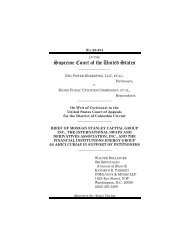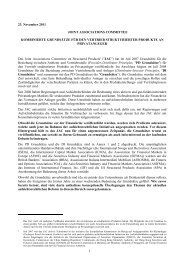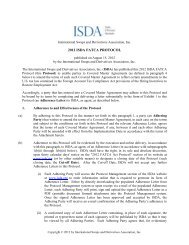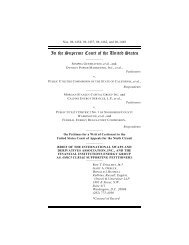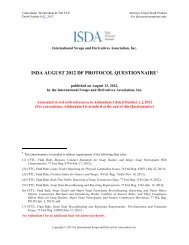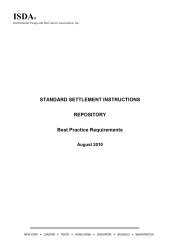24.06. 2011 Ministarstvo financija Republike Hrvatske mr.sc ... - ISDA
24.06. 2011 Ministarstvo financija Republike Hrvatske mr.sc ... - ISDA
24.06. 2011 Ministarstvo financija Republike Hrvatske mr.sc ... - ISDA
- No tags were found...
You also want an ePaper? Increase the reach of your titles
YUMPU automatically turns print PDFs into web optimized ePapers that Google loves.
The combination of the above beneficial factors would lead to a more robust legal analysis ofthe enforceability of close-out netting and collateral arrangements in Croatia.The need for legal certaintyFeedback from market participants indicates that interest in derivatives transactions withCroatian entities continues to increase. This is particularly the case in OTC derivatives,involving a wider range of asset classes, including financial collateral arrangements, as wellas with a greater diversity in counterparty types. This is partly related to the fact that theRepublic of Croatia shall become an EU member state in the very near future. We welcomethe fact that the Republic of Croatia has undertaken major efforts in implementing all relevantEU directives in the capital markets area, especially the Financial Collateral ArrangementsDirective (2002/47/EC), the Settlement Finality Directive (98/26/EC) as well as the WindingupDirective for Credit Institutions (2001/24/EC). We note that some of the provisions of theCroatian Credit Institutions Act, Official Gazette No. 117/08, 74/09, 153/09 4 implementingthe Winding-up Directive for Credit Institutions (including the netting provision stated underArticle 353 of the Credit Institutions Act) will enter into force upon the moment the Republicof Croatia joins the EU. Furthermore, we understand that historically the first close-outnetting provision in the Croatian legal system was given in Article 111 of the CroatianBankruptcy Act 5 , Official Gazette No. 44/96 (Banking Act, Official Gazette No. 161/98),29/99, 129/00, 123/03, Decisions on the Amendments to the Bankruptcy Act Official GazetteNo. 197/03 and 187/06, 82/06, 116/10 6 and that this provision is still in force in the Republicof Croatia 7 .The various aforementioned EU legal instruments make reference to close-out netting in oneway or another. The European Commission, in its report on the evaluation of theimplementation of the Financial Collateral Directive, acknowledged the crucial significanceof the legal concepts of close-out netting and set-off and stated that the “acqui<strong>sc</strong>ommunautaire” as to the definition of close-out netting and set-off needs to be furtherharmonized going forward (COM (2006) 833 final).As far as the current legal recognition of close-out netting in the Republic of Croatia i<strong>sc</strong>oncerned, <strong>ISDA</strong> has observed that the enforceability of close-out netting is included inCroatian provisions on the insolvency of Croatian entities.However, although Croatian law may recognize close-out netting principles andinternationally accepted OTC derivatives terminology, many market participants and legalexperts believe that Croatian law does not set out a clear position with respect toenforceability of close-out netting in the event of the bankruptcy of Croatian entities.In addition, <strong>ISDA</strong> has major concerns relating to the contradictory regulation dealing withclose-out netting under Article 111 of the Croatian Bankruptcy Act which appears to becontrary to both Article 8 of the Financial Collateral Law.In recognition of the substantial credit and systemic benefits of close-out netting and financialcollateral arrangements, many jurisdictions that were previously subject to doubts about theenforceability of netting and collateral arrangements, have introduced legislation to enable itor, more often, to strengthen the relevant legal regime. Examples in Europe include the vastmajority of EU member states (including Belgium, Czech Republic, Denmark, Finland,4 Croat.:“Zakon o kreditnim institucijama“, Narodne novine br. 117/08, 74/09, 153/095 The full text of Article 111 of the Bankruptcy Act is reproduced in Appendix B of this letter.6 Croat.“Stečajni Zakon“, Narodne novine 44/96 (Zakon o bankama, Narodne novine 61/98), 29/99, 129/00, 123/03, Uredbe oizmjenama i dopunama Stečajnog zakona, Narodne novine 197/03 i 187/06, 82/06, 116/107However, the stated provision of Article 111 of the Bankruptcy Act is not fully in accordance wdith EU Directives and fromour perspective it needs to be revised in the nearest future.



